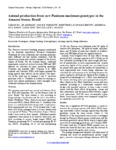Use este identificador para citar ou linkar para este item:
http://www.alice.cnptia.embrapa.br/alice/handle/doc/970774Registro completo de metadados
| Campo DC | Valor | Idioma |
|---|---|---|
| dc.contributor.author | ANDRADE, C. M. S. de | pt_BR |
| dc.contributor.author | FARINATTI, L. H. E. | pt_BR |
| dc.contributor.author | NASCIMENTO, H. L. B. do | pt_BR |
| dc.contributor.author | ABREU, A. de Q. | pt_BR |
| dc.contributor.author | JANK, L. | pt_BR |
| dc.contributor.author | ASSIS, G. M. L. de | pt_BR |
| dc.date.accessioned | 2013-11-07T11:11:11Z | pt_BR |
| dc.date.available | 2013-11-07T11:11:11Z | pt_BR |
| dc.date.created | 2013-11-07 | pt_BR |
| dc.date.issued | 2013 | pt_BR |
| dc.identifier.citation | Tropical Grasslands-Forrajes Tropicales, Cali, v. 1, n. 1, p. 1-5, Sept. 2013. | pt_BR |
| dc.identifier.uri | http://www.alice.cnptia.embrapa.br/alice/handle/doc/970774 | pt_BR |
| dc.description | The Panicum maximum breeding program coordinated by the Brazilian Agricultural Research Corporation (Embrapa) has been evaluating and selecting genotypes under different soil and climatic conditions, with the objective to release new cultivars adapted to the diverse regions of Brazil. For the Amazon biome, small-plot experiments carried out in Acre between 2003 and 2005 allowed the selection of some promising genotypes (Valentim and Andrade 2005; Valentim et al. 2006; Andrade and Valentim 2009), with higher potential for forage growth than cultivars on the market. The objec-tive of this work was to compare 2 new P. maximum genotypes with cv. Tanzânia in relation to carrying ca-pacity and animal performance, when managed under rotational stocking in the Amazon biome. | pt_BR |
| dc.language.iso | eng | eng |
| dc.rights | openAccess | eng |
| dc.subject | Panicum maximum cv Tanzânia | pt_BR |
| dc.subject | Acre | pt_BR |
| dc.subject | Oanicum maximum | pt_BR |
| dc.subject | Aclimatación | pt_BR |
| dc.subject | Factores ambientales | pt_BR |
| dc.subject | Híbridos | pt_BR |
| dc.subject | Pastizales | pt_BR |
| dc.subject | Pastos forrajeros | pt_BR |
| dc.title | Animal production from new Panicum maximum genotypes in the Amazon biome, Brazil. | pt_BR |
| dc.type | Artigo de periódico | pt_BR |
| dc.date.updated | 2017-06-27T11:11:11Z | pt_BR |
| dc.subject.thesagro | Pastagem | pt_BR |
| dc.subject.thesagro | Gramínea forrageira | pt_BR |
| dc.subject.thesagro | Capim Colonião | pt_BR |
| dc.subject.thesagro | Seleção genótipa | pt_BR |
| dc.subject.thesagro | Comportamento de variedade | pt_BR |
| dc.subject.thesagro | Aclimatação | pt_BR |
| dc.subject.nalthesaurus | Pastures | pt_BR |
| dc.subject.nalthesaurus | Forage grasses | pt_BR |
| dc.subject.nalthesaurus | Hybrids | pt_BR |
| dc.subject.nalthesaurus | Environmental factors | pt_BR |
| dc.subject.nalthesaurus | Acclimation | pt_BR |
| dc.description.notes | Publicado também nos Anais do 22º INTERNATIONAL GRASSLAND CONGRESS, Sidney, 2013. | pt_BR |
| riaa.ainfo.id | 970774 | pt_BR |
| riaa.ainfo.lastupdate | 2017-06-27 | pt_BR |
| dc.contributor.institution | CARLOS MAURICIO SOARES DE ANDRADE, CPAF-AC; Luis H. E. Farinatti, Universidade Federal do Acre (Ufac); Hemython L. B. do Nascimento, Universidade Federal de Viçosa (UFV); Andressa de Q. Abreu, Universidade Federal do Acre (Ufac); Liana Jank, Embrapa Acre; GISELLE MARIANO LESSA DE ASSIS, CPAF-AC. | pt_BR |
| Aparece nas coleções: | Artigo em periódico indexado (CPAF-AC)  | |
Arquivos associados a este item:
| Arquivo | Descrição | Tamanho | Formato | |
|---|---|---|---|---|
| 24734.pdf | 313.02 kB | Adobe PDF |  Visualizar/Abrir |









